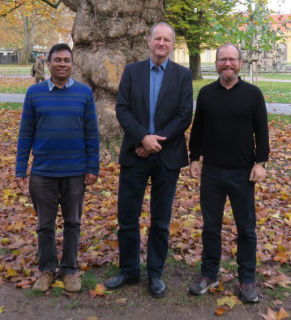Alexander von Humboldt almost brings the ocean to Erlangen
In this year´s 250th birthday celebration the Alexander von Humboldt foundation financed two acclaimed researchers to work for six months at the Chair of Applied Geology / GeoZentrum Nordbayern, Friedrich-Alexander-Universität Erlangen-Nürnberg.
Profs. Walter Daesslé-Heuser from Mexico and Rohana Chandrajith from Sri Lanka are both working on coastal groundwater systems. This topic gains increasing importance because more than half of the global population lives close to the ocean and therefore cause high demands on coastal groundwaters. An associated concern is seawater intrusion into coastal groundwater systems. These can compromise groundwater quality.
The visit to Erlangen of two experts in this field is a unique chance because it allows comparisons of similar systems in completely different climatic environments. While arid groundwater systems in Mexico may be under stress because of little rainfall replenishment, similar sandy groundwater systems in Sri Lanka are likely protected by rapid replenishment via monsoon rains. Both researchers use geochemical and stable isotope analytical facilities of the Applied Geology group at GeoZentrum Nordbayern. Successful collaborations exist for many years and have yielded several international publications.
References of common work:
Balasooriya, S. et al., submitted. Possible links between groundwater geochemistry and chronic kidney diseases of unknown etiology (CKDu): An investigation from the Ginnoruwa region in Sri Lanka. Exposure and Health.
Bandara, U.G.C. et al., 2018. Arsenic-rich shallow groundwater in sandy aquifer systems buffered by rising carbonate waters: A geochemical case study from Mannar Island, Sri Lanka. Science of The Total Environment, 633: 1352-1359.
Chandrajith, R., Barth, J.A.C., Subasinghe, N.D., Merten, D., Dissanayake, C.B., 2013. Geochemical and isotope characterization of geothermal spring waters in Sri Lanka: Evidence for steeper than expected geothermal gradients. Journal of Hydrology, 476: 360-369.
Chandrajith, R. et al., 2014. Quantification of groundwater-seawater interaction in a coastal sandy aquifer system: A study from Panama, Sri Lanka. Environmental Earth Sciences, 72(3): 867-877.
Chandrajith, R. et al., 2016. Controls of evaporative irrigation return flows in comparison to seawater intrusion in coastal karstic aquifers in northern Sri Lanka: Evidence from solutes and stable isotopes. Science of the Total Environment, 548-549: 421-428.
Chandrajith, R., Jayasena, H.A.H., van Geldern, R., Barth, J.A.C., 2015. Assessment of land subsidence mechanisms triggered by dolomitic marble dissolution from hydrogeochemistry and stable isotopes of spring waters. Applied Geochemistry, 58: 97-105.
Daesslé, L.W. et al., submitted. Groundwater recharge sites and pollution sources in the wine-producing Guadalupe Valley. Restrictions and mixing prior to transfer of reclaimed water from the US-México border. Science of the Total Environment.
Daesslé, L.W. et al., 2017. Sources and sinks of nutrients and organic carbon during the 2014 pulse flow of the Colorado River into Mexico. Ecological Engineering, 106: 799-808.
Daesslé, L.W., van Geldern, R., Orozco-Durán, A., Barth, J.A.C., 2016. The 2014 water release into the arid Colorado River delta and associated water losses by evaporation. Science of the Total Environment, 542: 586-590.
Orozco-Durán, A., Daesslé, L.W., Camacho-Ibar, V.F., Ortiz-Campos, E., Barth, J.A.C., 2015. Turnover and release of P-, N-, Si-nutrients in the Mexicali Valley (Mexico): Interactions between the lower Colorado River and adjacent ground- and surface water systems. Science of the Total Environment, 512-513: 185-193.

